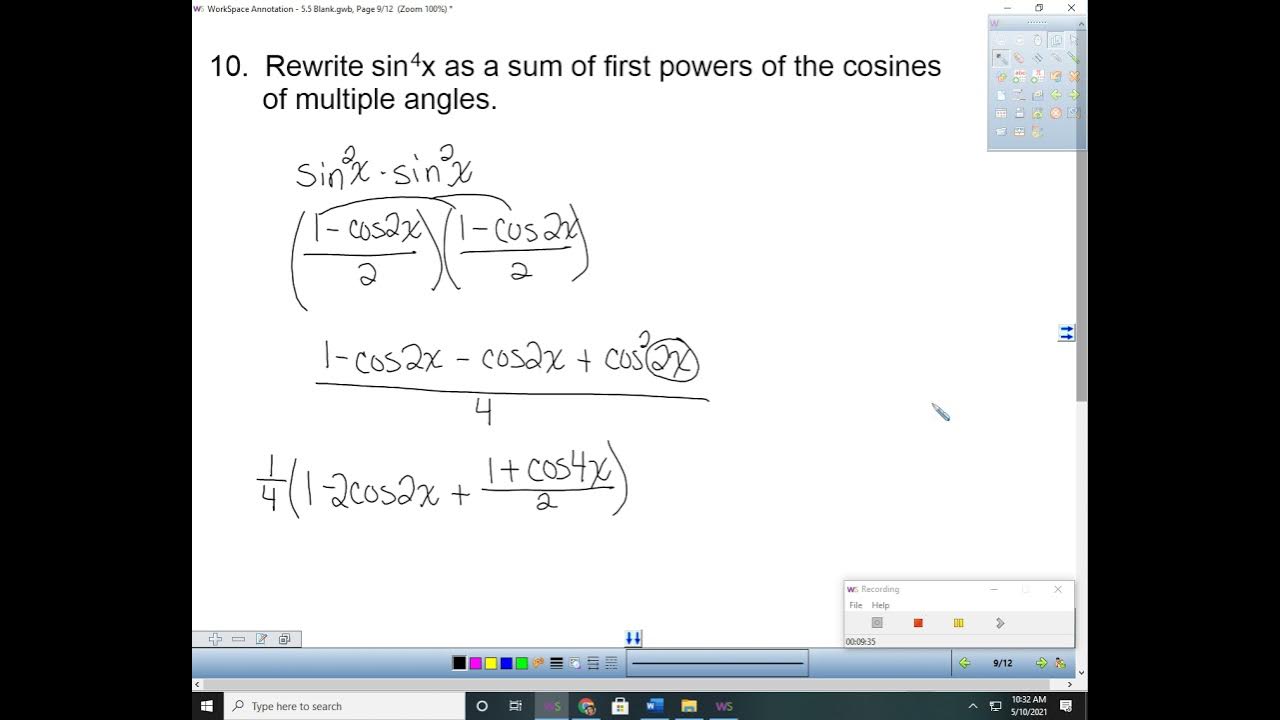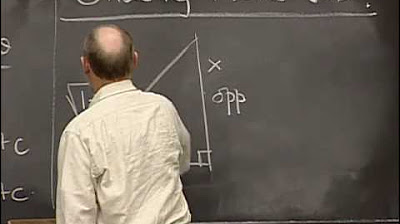Trig Integral Practice | MIT 18.01SC Single Variable Calculus, Fall 2010
TLDRIn this recitation, Joel Lewis revisits integrals involving trigonometric functions, offering three additional examples to supplement Professor Miller's lecture. He emphasizes the importance of trigonometric identities, particularly the angle sum identity for cosine, for solving these integrals. Lewis demonstrates the integration process for expressions like sine cubed x secant squared x, using substitutions and trigonometric identities to simplify the calculations. He also tackles more complex integrals involving multiple trigonometric functions with different arguments, such as sine x cosine of 2x and sine 2x cosine 3x, guiding students through the process of simplifying and integrating these expressions.
Takeaways
- 📚 The video is a continuation of a lecture series on integrals involving trigonometric functions.
- 🔍 The focus is on three additional integral examples that require the use of trigonometric identities.
- 🧠 The angle sum identity for cosine is essential for solving one of the integrals: cos(a + b) = cos a cos b - sin a sin b.
- 📝 The first integral involves secant squared, which is closely related to the cosine function, and is expressed as 1/cosine.
- 🤔 The integral of sine cubed x secant squared x is simplified by breaking it down to involve powers of sine and cosine.
- 📉 The substitution method is used for integration, where u is set to cosine x, simplifying the integral to a form involving u to the power of -2.
- 🔄 The double angle formula is applied to transform cosine 2x into a form involving only sine and cosine of x.
- 📈 The integral of sine x times cosine 2x is simplified using the double angle formula and then solved using substitution.
- 📌 The third integral involves sine 2x and cosine 3x, which are both transformed using double angle and sum formulas to simplify the expression.
- ✍️ The final answer for the third integral is given as a combination of cosine terms with different powers, resulting in a constant of integration.
- 📝 The script encourages students to pause the video to work through the integrals and check their answers against the provided solutions.
Q & A
What is the main focus of the recitation session led by Joel Lewis?
-The main focus of the recitation session is to provide additional examples of integrals involving trigonometric functions, building on what was covered in Professor Miller's lecture.
Which trigonometric identity is highlighted as important for solving one of the integrals?
-The angle sum identity for cosine, which states that cos(a + b) = cos(a)cos(b) - sin(a)sin(b), is highlighted as important for solving one of the integrals.
How does Joel Lewis suggest handling integrals where sine appears with an odd power?
-Joel Lewis suggests breaking up the sine term so that it includes one instance of sine and converting the remaining sine squared terms into 1 - cos^2. This simplifies the integral by reducing it to a form involving sine and cosine.
What substitution does Joel Lewis use for the first integral involving sine cubed x secant squared x?
-For the first integral, Joel Lewis sets u equal to cos(x), which simplifies the integral by converting sine terms to du and cosine terms to u.
What is the result of the first integral after substitution and simplification?
-The result of the first integral is sec(x) + cos(x) + C.
What double angle formula does Joel Lewis use to simplify the second integral involving sine x cosine 2x?
-Joel Lewis uses the double angle formula for cosine, cos(2x) = 2cos^2(x) - 1, to simplify the second integral.
What is the simplified result for the second integral involving sine x cosine 2x?
-The simplified result for the second integral is -2/3 cos^3(x) + cos(x) + C.
How does Joel Lewis handle the integral involving sine 2x cosine 3x?
-Joel Lewis handles the integral involving sine 2x cosine 3x by expressing both functions in terms of sine and cosine of x using angle sum and double angle formulas, then simplifying.
What is the result of the third integral after simplification?
-The result of the third integral is -8/5 cos^5(x) + 2 cos^3(x) + C.
Why is it important to write everything in terms of sine x and cosine x for the integrals discussed?
-It is important to write everything in terms of sine x and cosine x to make the integrals easier to solve using substitutions and familiar trigonometric identities.
Outlines
📚 Introduction to Trigonometric Integrals
Joel Lewis begins the recitation by welcoming students back and referencing the lecture on integrals involving trigonometric functions by Professor Miller. He introduces three additional integral examples that students should attempt, emphasizing the importance of recalling trigonometric identities, specifically the angle sum identity for cosine. Lewis encourages students to pause the video to work through the problems and then return to compare their answers. The first integral discussed is sine cubed x secant squared x, and Lewis explains the relationship between secant and cosine, suggesting a substitution method to simplify the integral.
🔍 Simplifying Trigonometric Integrals with Substitutions
The second paragraph delves into the process of simplifying the integral of sine x times cosine of 2x. Lewis explains that the integral involves a trigonometric function of 2x, necessitating the use of double angle formulas to express the integral in terms of sine and cosine of x. He outlines the steps for substitution, using u as a variable to represent cosine x, and simplifies the integral to a form that can be easily integrated. The summary includes the application of double angle formulas and the final result of the integral.
📘 Advanced Trigonometric Integral Techniques
In the third paragraph, Lewis tackles the more complex integral involving sine 2x and cosine 3x. He discusses the importance of having matching arguments in trigonometric integrals and uses the angle sum identity to express cosine 3x in terms of sine and cosine of x. Lewis then applies the double angle formula to sine 2x and simplifies the integral to a form involving powers of cosine and a single power of sine. He suggests a substitution method for simplification but does not complete the process, instead providing the final answer for students to verify their work.
Mindmap
Keywords
💡Trigonometric functions
💡Integrals
💡Trig identities
💡Angle sum identity
💡Secant function
💡Odd power
💡Substitution
💡Double angle formula
💡Cosine sum formula
💡Integration by parts
💡Constant of integration
Highlights
Introduction to integrating trigonometric functions, focusing on examples different from those in the lecture.
Reminder of the cosine angle sum identity: cos(a + b) = cos(a)cos(b) - sin(a)sin(b).
First integral example: Integrating sine cubed x secant squared x.
Explanation of secant as 1 over cosine and transforming the integral into a power of sine and cosine.
Strategy for integrals with odd powers of sine: Break down sine cubed x into sine x times sine squared x.
Substitute sine squared x with 1 - cosine squared x to simplify the integral.
Introduction of u-substitution: Let u = cos(x) and du = -sin(x)dx.
First integral solution: Resulting in sec(x) + cos(x) + C.
Second integral example: Integrating sine x cosine 2x.
Use of double angle formula for cosine: cos(2x) = 2cos^2(x) - 1.
Simplification using substitution u = cos(x), leading to the integral of 2cos^2(x)sin(x).
Second integral solution: Resulting in -2/3 cos^3(x) + cos(x) + C.
Third integral example: Integrating sine 2x cosine 3x.
Application of angle sum formula and double angle formula to express cos(3x) and sin(2x) in terms of sine and cosine.
Third integral solution: Resulting in -8/5 cos^5(x) + 2 cos^3(x) + C.
Transcripts
Browse More Related Video

Product To Sum Identities and Sum To Product Formulas - Trigonometry

5.5 Multiple Angle and Product to Sum Formulas (Part 2)

Calculus 2 - Basic Integration

Lec 28 | MIT 18.01 Single Variable Calculus, Fall 2007

Ultimate trig identity problem study guide!

Derivative of Sine and Cosine Functions | Calculus
5.0 / 5 (0 votes)
Thanks for rating: